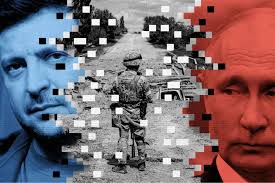The Digital Battlefield: AI, Social Media, and the War of Narratives in Ukraine
The ongoing conflict between Russia and Ukraine has unveiled a new dimension of warfare, one fought not just on land and sea but also across the digital landscape of social media. This “TikTok war,” as it has been dubbed, highlights the potent role of artificial intelligence and social media platforms in shaping public perception and disseminating disinformation on an unprecedented scale. The sheer volume of war-related content circulating online, coupled with the sophisticated use of AI-powered bots and deepfakes, has created a chaotic information environment where truth becomes elusive and manipulation runs rampant.
At the heart of this digital conflict lies the battle of narratives. Russia portrays the invasion as a necessary measure to counter NATO expansion and combat alleged Nazism in Ukraine. Conversely, Ukraine presents itself as a sovereign nation defending against unprovoked aggression. These competing narratives are amplified and distorted through the use of AI-powered tools. Deepfake videos, fabricated speeches, and manipulated images blur the lines between reality and fiction, making it increasingly difficult for the public to discern credible information. The narrative war extends beyond the primary actors, with countries like China and Belarus engaging in disinformation campaigns aimed at diminishing Russia’s culpability and promoting anti-Western sentiment.
The pervasiveness of social media platforms like TikTok and Facebook has transformed them into the new “mass media,” reaching billions of users worldwide. The algorithms that govern these platforms, designed to maximize engagement, inadvertently contribute to the spread of misinformation by prioritizing sensational content, regardless of its veracity. The sheer scale of content related to the war, with billions of views on hashtags like #Russia and #Ukraine in the conflict’s initial days, overwhelms moderation efforts and allows disinformation to proliferate unchecked. This creates a feedback loop, where users are exposed to a constant barrage of conflicting information, escalating polarization and eroding trust in traditional news sources.
The challenges of content moderation are particularly acute on platforms like TikTok, where the ease of creating and sharing short-form videos facilitates the rapid dissemination of unverified information. The platform’s algorithm, often criticized for promoting divisive content, has been exploited to spread disinformation, with new users encountering fabricated narratives within minutes of creating an account. Similarly, Facebook has struggled to effectively label and remove posts containing conspiracy theories and false claims related to the conflict, further contributing to the spread of misinformation. This failure to effectively regulate content underscores the limitations of current moderation strategies and the urgent need for more robust solutions.
The use of AI-powered bots further exacerbates the problem. Russia has been accused of deploying armies of bots to amplify pro-Kremlin narratives and drown out dissenting voices. These bots create fake profiles, spread disinformation, and manipulate trending topics, creating an illusion of widespread support for Russia’s actions. The deletion of tens of thousands of fake accounts by Twitter highlights the scale of this bot activity and the deliberate effort to manipulate online discourse. The prevalence of deepfakes adds another layer of complexity, with fabricated videos of political leaders like Vladimir Putin and Volodymyr Zelenskyy used to mislead and manipulate public opinion.
Combating this wave of AI-driven disinformation requires a multi-pronged approach involving governments, technology companies, and civil society. Social media platforms must invest in more sophisticated AI tools to detect and remove misleading content, while governments need to implement policies that hold platforms accountable for the spread of disinformation. International cooperation is essential to address the cross-border nature of this challenge. Efforts to promote media literacy and critical thinking skills among the public are also crucial, empowering individuals to navigate the complex information landscape and distinguish fact from fiction. The ongoing development of fact-checking initiatives and the collaboration between news organizations and tech companies to verify information are steps in the right direction, but the constantly evolving nature of AI-powered disinformation demands continuous innovation and adaptation. Ultimately, winning the information war requires a collective commitment to upholding truth and transparency in the face of unprecedented technological challenges. The future of democracy itself may depend on our ability to effectively counter the spread of AI-powered disinformation and protect the integrity of the information ecosystem.


